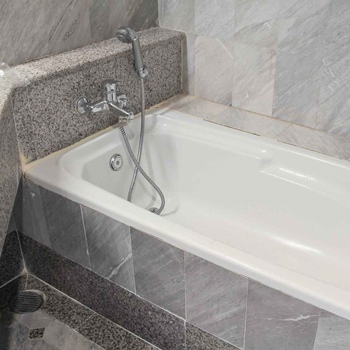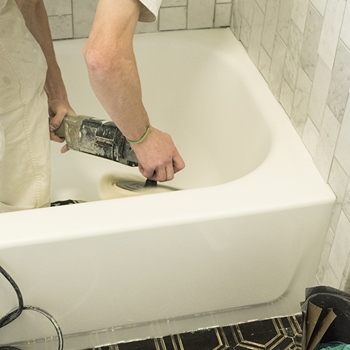So, it’s finally time to give the old bathtub a fresh new coat, eh? This process is done by professionals for a reason – the chemicals used are not exactly the safest out there, and the consequences can be hazardous to human health. Once the job is done, one thing remains – the pungent smell of the fresh new enamel. Fighting this scent may seem easy, but it is nothing like what we are used to. In other words, it is not nearly the same as combating the smell of bodily functions.
It is extremely important to learn how to deal with the fumes that stay behind the bathtub refinishing process. They pose a real threat to your health and the wellbeing of anyone you share the bathroom with. So, stick around and see how to approach this subject properly, making your bathroom available again.
What Exactly Is Bathtub Refurbishing Odor?
 Let’s say that you have decided to give your bathroom a fresh new touch by investing in bathtub refurbishment. Nothing wrong there. As a matter of fact, I fully support taking care of your tub, not only for aesthetical reasons but for practical benefits as well. A refurbished bathtub will look nice, yes, but the process of refinishing fixes all the tub issues as well. Cracks, dents, holes, you name it.
Let’s say that you have decided to give your bathroom a fresh new touch by investing in bathtub refurbishment. Nothing wrong there. As a matter of fact, I fully support taking care of your tub, not only for aesthetical reasons but for practical benefits as well. A refurbished bathtub will look nice, yes, but the process of refinishing fixes all the tub issues as well. Cracks, dents, holes, you name it.
But no matter if you decide to DIY it or call a professional, one thing is certain – some fumes will stay in your bathroom, possibly days after the tub is done. While the smells are not unpleasant to everyone, it is potentially hazardous to your health if you breathe too much of it. The biggest culprit here is a chemical called methylene chloride.
Methylene chloride is extremely dangerous if not used properly. In most cases, it plays the role of a solvent, helping with all sorts of industrial-grade chemicals, including the ones we use to refurbish the old bathtub. The main problem with this particular chemical is that it is organic and generally lightweight – it is a gaseous solution that spreads fast. Being that it is poisonous, ventilation should be the main concern during bathroom renovations.
Another issue with methylene chloride is that it evaporates quickly, and the tricky part is – if you smell it, you have already been overexposed. However, there are solutions to this issue as well. Our bodies can handle some of this hazardous gas, but prolonged exposure can lead to health problems quickly.
The Dangers of Bathtub Refurbishing Smells
The very first thing that methylene chloride affects is the mental capacity of the exposed person. Yes, that sounds horrible and it should be taken seriously. Prolonged exposure affects respiratory organs, and can lead to a complete halt in the lungs. As you can see, this is not a chemical to be taken lightly.
The immediate effects of bathtub refinishing odors depend on several factors:
- The amount of the chemical used in the process
- Exposure time, aka how long have you been breathing it
- Pre-existing conditions of the person exposed to the fumes. People with asthma or similar respiratory issues are at risk the most.
It is important to remember that methylene chloride is a volatile organic substance. As all chemicals of this type go, this one also has a direct risk to cancer, so I beg you to be careful around it!
Dealing with Bathtub Refinishing Smells and Fumes
The best way to deal with bathtub refurbishing smells is a rather proactive approach which you might find strange – do not try to DIY the process. Hiring a professional bathtub renovator has its own merits, besides the time spent dealing with dangerous chemicals.
A professional will use the least amount of dangerous chemicals needed. They have experience and adequate protective gear to deal with the fumes. Also, limiting the exposure time to a minimum is the key to not getting any side effects. An experienced bathroom refinisher will also avoid spilling or leaving any dangerous chemicals behind. They will also know how to deal with potential spills.
But, once the professional crew is done, the bathtub refurbishing smell remains. Here are some tips on how to deal with the leftover fumes in your bathroom:
1. Ventilation!
 As far as any dangerous (or downright unbearable) smell goes, ventilating the room should be your first step towards regaining your bathroom. Larger bathrooms are easier to ventilate, but don’t underestimate the potential of bathroom refurbishing chemicals – open all windows, and keep them like that as long as possible.
As far as any dangerous (or downright unbearable) smell goes, ventilating the room should be your first step towards regaining your bathroom. Larger bathrooms are easier to ventilate, but don’t underestimate the potential of bathroom refurbishing chemicals – open all windows, and keep them like that as long as possible.
Smaller bathrooms can be easily ventilated as well. Opening the windows helps, yes, but you can also invest in a ventilating fan to help you push the fumes out. Some professionals even install ventilating tubes that directly connect the tub and the outside. Ask the person in charge of refurbishing your bathtub for advice, they will surely be able to tell you how to optimize the ventilating process.
At best, you can get rid of the fumes in just under 48 hours. Even after you stop smelling the nasty odor, keep ventilating the room because you may have just gotten used to the smell and the chemical is still present.
Lastly, the thing you absolutely must avoid is masking the smell of refurbishing chemicals with air fresheners. Not only will you get the illusion that the danger is gone, but you also risk causing a chemical reaction in the air. As I mentioned above, methylene chloride is a volatile substance that evaporates and spreads quickly.
2. Protective Gear
In the case of bathtub refurbishing fumes, you will need special protection in the form of respiratory masks. Not any masks, mind you – but special masks with organic filters inside. If you are not sure how or where to get such a mask with organic filters, ask the person that did the bathtub refurbishing. They will point you towards the best option since they must use these masks every day as a part of their job.
Also, if you must spend time in the bathroom riddled with bathroom refurbishing fumes, learn how to put the mask on your face properly. A respiratory mask that protects against organic chemicals is pointless if not used adequately.
3. Time
Lastly, the best way to get rid of the bathtub refurbishing smells is to wait. Optimize the ventilation air path in the bathroom and give the fumes time to dissipate. These fumes are lightweight, and the whole waiting process should not take long- 2 or 3 days on average.
If the odor can be sensed in the bathroom even after three days, call the bathtub refinisher and ask for directions. The chances are something went wrong and the person in charge needs to come and inspect the new layer of your bathtub.
Wrap Up
There is nothing more annoying than an unavailable bathroom. After all, we all spend a significant part of our lives in this room, so why not make it as pleasurable as possible. Bathtub refinishing agents and the smelly fumes that stay behind are dangerous and the subject needs to be treated as such.
I sincerely hope that this little guide finds you in good health and that you manage to deal with this exhausting issue quickly and painlessly. Bathtub refinishing is not something we do often, but it is crucial you want to prevent water damage and all sorts of structural issues with your bathroom. Drawing a hot bath and soaking in it is a special event, no matter how rarely or often you do it, so make it the best experience you can. Stay safe and enjoy your home life!